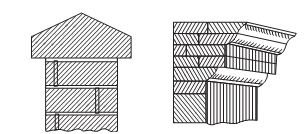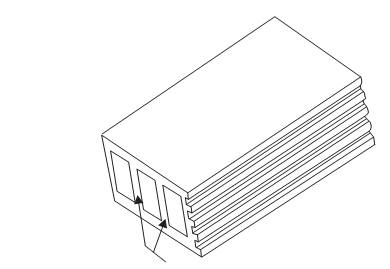Bricks may be broadly classified as following:
- Paving bricks
- Building bricks
- Special bricks
A. Fire bricks
B. Building Bricks: These bricks are utilized for the construction of walls.
C. Paving Bricks: These are vitrified bricks and can be used as pavers.
D. Fire Bricks: These bricks are especially composed to withstand furnace temperature. Silica bricks belong to this type of category.
E. Special Bricks: These bricks are different from the usually used building bricks with respect to their shape and the purpose for which they are composed. Some of such bricks are listed below:
(i) Facing bricks
(ii) Specially shaped bricks
(iii) Sewer bricks
(iv) Burnt clay hollow bricks
(v) Perforated building bricks
(vi) Acid resistant bricks.
(i) Specially Shaped Bricks: Bricks of special shapes are composed to meet the need of different situations. Some of them are shown in given figure

Bull nosed brick Cant brick Plinth brick


Coping brick Cornice brick Channel brick
Special shaped bricks
(b) Facing Bricks: These bricks are utilized in the outer face of masonry. Once these type of bricks are provided, plastering is not needed. The standard size of these bricks is 190 × 90 ×90 mm or 190 × 90 × 40 mm.
(c) Perforated Building Bricks: These bricks are composed with area of perforation of 30 to 45 per cent. Area of each perforation should not exceed 500 mm2. The perforation should be evenly distributed over the surface. They are composed in the size 190× 190 × 90 mm and 290 × 90 × 90 mm.
(d) Burn't Clay Hollow Bricks: Given figure shows a burnt clay hollow brick. They are light weighted. They are utilized for the construction of partition walls. They provide good thermal insulation to buildings. They are composed in the sizes 190 × 190 × 90 mm and 290 × 90 × 90 mm and 290 × 140 × 90 mm. The thickness of any shell might not be less than 11 mm and that of any web not less than 8 mm.

WEBS 8 mm minimum thick
Hollow bricks
(e) Sewer Bricks: These bricks are utilized for the construction of sewage lines. They are composed from fire clay shale, surface clay, or with the combination of both. They are composed in the sizes190 × 90 × 40 mm and 190 × 90 × 90 mm. The average strength of these bricks might be a minimum of 17.5 N/mm2 . The water absorption should not be more than 10 per cent.
( f ) Acid Resistant Bricks: These bricks are utilized for floorings likely to be subjected to acid attacks, lining of sewers carrying industrial wastes, lining of chambers in chemical plants, etc. These bricks are composed of clay or shale of suitable composition with iron content and low lime, flint or sand and vitrified at high temperature in a ceramic kiln.